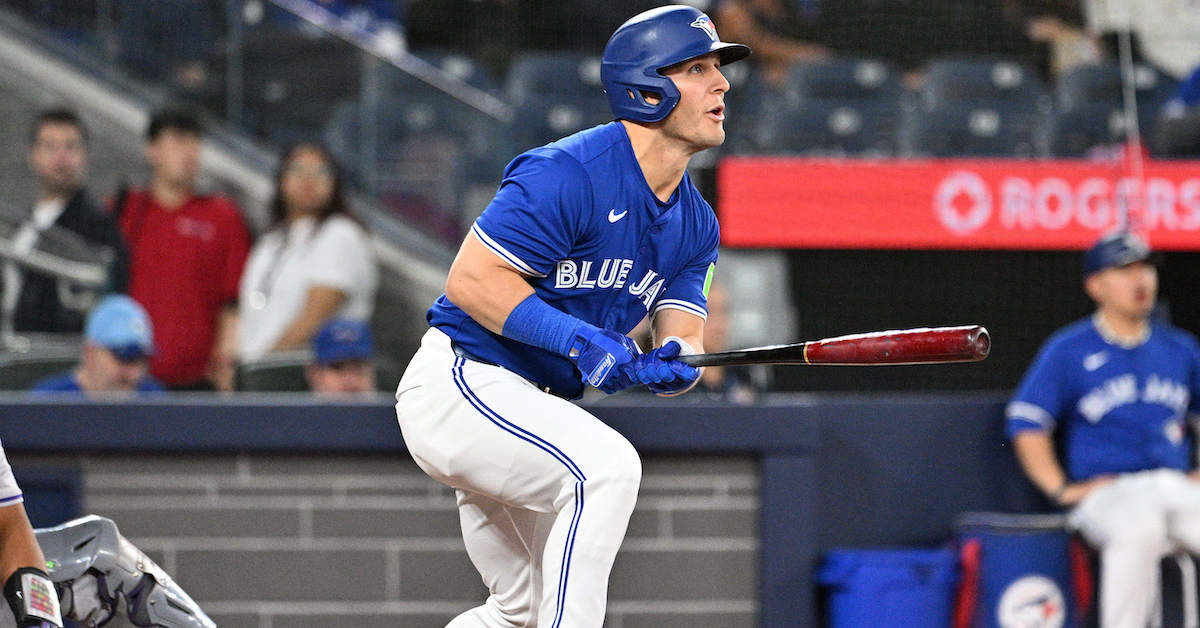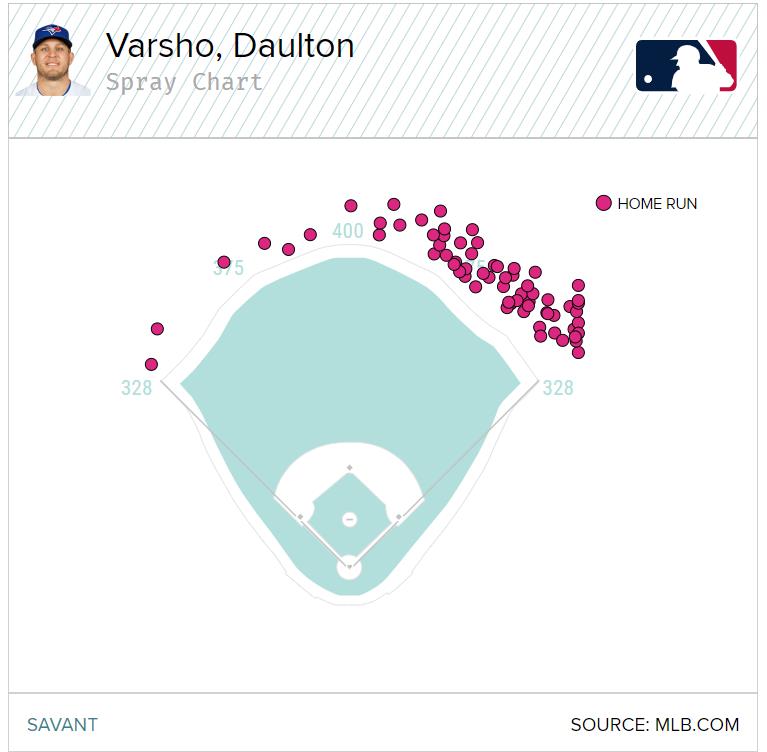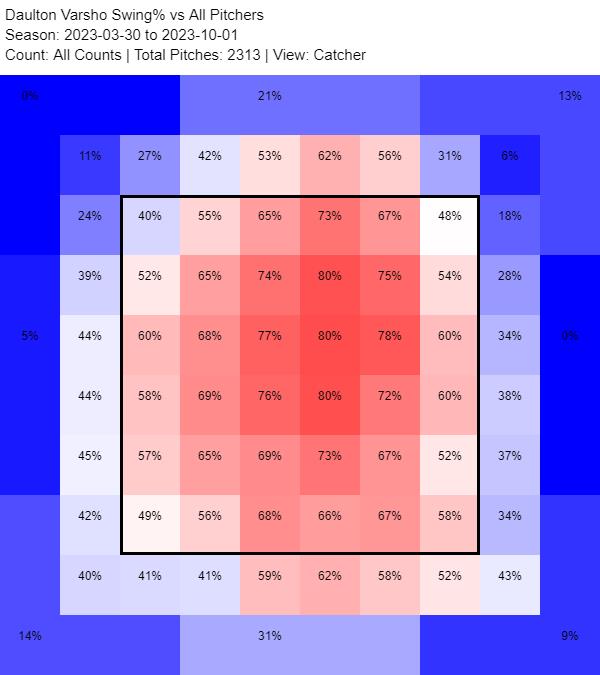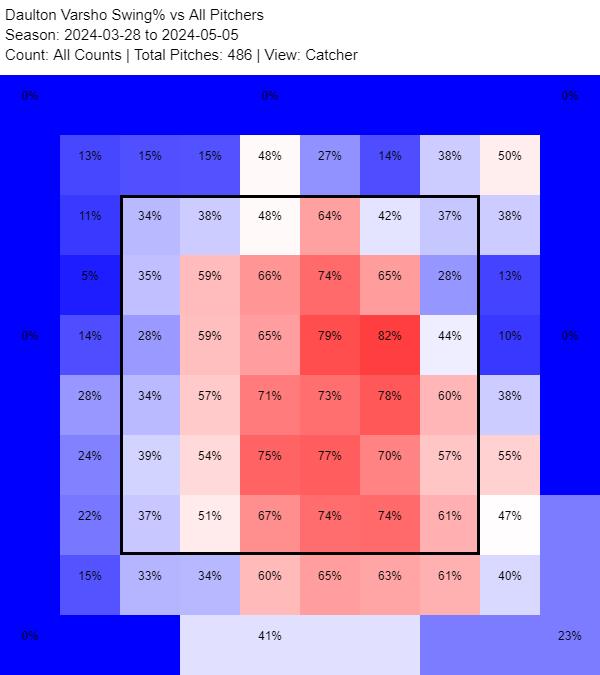
Dan Hamilton-USA TODAY Sports
Daulton Varsho must have been bummed. After a breakout 2022, he got traded to Toronto, a World Series contender with a desperate need for outfielders. Then he had a down season, the Jays got swept out of the Wild Card round, and his old team made a surprise run to the World Series. Gabriel Moreno and Lourdes Gurriel Jr., the players Arizona got back for Varsho, were key parts of that run. Oh, what could have been.
The most worrisome of all those happenings, from Varsho’s perspective, was surely his own performance. Everything else was either partially or fully outside of his control, but this one seemed mostly on him, and it’s hard to add value offensively when you’re getting on base at a .285 clip. Yes, he’s a great defensive player and adds value on the basepaths, but most of a position player’s value comes from hitting, and quite frankly, his just wasn’t good enough.
But ah, how the tables have turned. A year after being one of the weakest links on an excellent Toronto offense, he’s one of the best players on a lackluster unit. Among Jays regulars, only Justin Turner and Davis Schneider have hit better. (Danny Jansen hasn’t played enough yet to count as a “regular” in my eyes.) There’s not much he can do about the rest of the team, but Varsho has reversed his own fortunes for the moment. Now there are two questions: How did he do it, and can he keep it going?
A quick look at Varsho’s rate statistics would suggest one big change: He’s walking more. He’s running an 11.7% walk rate this year, up from 7.7% a year ago, without adding any strikeouts. And indeed, few hitters in baseball have lowered their swing rate by more than Varsho. He’s both chasing less and swinging at pitches in the zone less. His swinging strike rate is way down, he’s getting ahead more often, the whole nine yards. Did we solve it? If so, that’s great, I can shut this article down early and go get lunch.
Bad news for Hungry Ben: We didn’t solve it. In fact, Varsho’s swing rate looks like a red herring to me. If you break things down by zones, I’m not even sure his change is a sustainable good thing. His heart swing rate has declined from 78% to 73%, bang on league average. His swing rate on pitches in the chase zone, meanwhile, went from 20% to 17%. He was already pretty good at laying off bad pitches, and he hasn’t improved much. He’s swinging at fewer pitches on the fringes of the plate or just off of it, but those swings are tricky to judge. The headline thing that’s going on here is fewer swings at hittable pitches, though, and not enough extra takes on breaking balls to make up for it.
Wait, is there nothing to solve? Varsho’s xwOBA has gone down while his results have gone up. By that particular metric, he’s having his worst year in the majors. Is this just a matter of luck, something that will disappear in the fullness of time and leave Varsho looking like last year’s model, or perhaps even worse? Sadly again for my lunchtime plans, I don’t think so. But good news for Varsho: I think that he’s tapping into something trickier to measure.
You probably think of Varsho as a power hitter, or at least close to one. He’s working on two straight seasons of 20 or more homers, and he’s built like a running back, 5’10” and chiseled. He’s fast and strong, which is how you end up as a catcher/center field hybrid as a prospect. But the data paints a different picture. His exit velocity numbers aren’t particularly imposing. Even in 2022, his best offensive season to date, he was in the 40th percentile on the EV of his top 50% of batted balls. He’s maxed out at 112.5 mph across his entire big league career, a number 48 hitters have already surpassed this year, and 124 batters hit a ball harder than that last year. He’s annually in the bottom third of baseball in hard-hit rate.
Varsho’s home runs aren’t because of his massive raw power. They come courtesy of a strategy best exemplified by division rival Isaac Paredes: Find the nearest wall and get the ball over it. This chart should help explain it:

Ah, yes. Put it in the air and pull it, and medium power plays up. That’s particularly the case given the recent changes to the outfield in Toronto; a 2023 renovation moved the right center field wall 16 feet closer to home plate (and 4.5 feet higher). Park factors take a while to stabilize, but Rogers Centre was an average park for lefty power in the previous decade. It stands to reason that it’s better than that now.
You know how I said that all of Varsho’s swing changes were smoke and mirrors? That might be true as it relates to his hunting of middle-middle pitches, but that’s not to say that nothing has changed. You can’t tap into your pull side power if you don’t pull the ball, and it’s hard to pull pitches on the outer half of the strike zone.
In 2024 so far, lefties are pulling 41% of their aerial contact when they swing at pitches on the inner third of the strike zone. That number falls to 21% on the outer third. This is just a physics problem; think about the angle the bat makes when it hits a ball in each location and you’ll get the idea pretty quickly. Varsho is no exception to this rule; he’s pulling 58% of his inner-third fly balls and only 24% on the outer third.
We know that Varsho is swinging less often this year. Where are those missing swings? On the outer third, more or less. Take a look at his swing rates by horizontal slice over his career. I’ve added the areas just off the plate on both sides to bulk up the sample, and also because those are more opportunities to put the ball in play:
Daulton Varsho’s Swing Rate by Location
| Year |
Inner Third |
Middle Third |
Outer Third |
| 2020 |
59.7% |
62.9% |
72.7% |
| 2021 |
69.1% |
77.4% |
68.1% |
| 2022 |
64.1% |
74.9% |
65.7% |
| 2023 |
71.0% |
77.0% |
62.5% |
| 2024 |
73.2% |
74.3% |
48.6% |
That’s a stark change. He’s mostly given up the outside part of the plate. Last year, he was in the top third of lefty hitters when it came to outer-third swing rate. This year, he’s 106th out of 125, a 15th percentile mark. Meanwhile, he’s swinging more at the pitches where he can lift and pull. If you’re a visual person, look at it this way. Here are his swing rates from 2023:

And here they are in 2024:

That’s a phenomenally important change. Pull-power hitters shouldn’t be swinging at pitches without regard for their horizontal location; they should be maximizing their damage potential. Varsho’s new approach does an excellent job of that. His pull rate on fly balls is up from 41% last year to 52% so far in 2024, and 22.5% of his plate appearances this year have ended with a pulled ball in the air, up from 18% last season and a pre-2024 career mark of 16.3%.
Why is Varsho outperforming his xwOBA? It’s at least partially because he’s crushing on these pulled fly balls. Despite uninspiring exit velocities, he’s producing a .772 wOBA on them, as compared to a .522 xwOBA. That’s what pull hitters with medium exit velocities do, as I found in research about Paredes. If you have an average amount of juice, aiming for the nearest wall does wonders, particularly when your team moves that wall in.
I truly don’t know if he can make all these changes stick. After going 0-for-4 on Wednesday, he’s mired in a 12-game homerless stretch, though he’s been just a bit below average at the plate overall in that window thanks to his newfound walks. Truthfully, it’s hard to make an adjustment this extreme without creating problems somewhere else. He’s flirting with being too fly ball oriented; his popup rate is at a career high and his line drive rate is at a career low. His new approach is boom or bust, too; if the ball isn’t leaving the yard, it’s probably finding a glove.
In my eyes, though, those weaknesses are a reasonable tradeoff. We’re talking about an elite defender with game-breaking speed here. He doesn’t need to be the best hitter in the world to make the whole package work. If he’s a 30-homer guy instead of 20, adds some doubles off of that new higher wall, and sprinkles in the occasional bunt single like he has throughout his career, he could be 15-20% better than average offensively pretty easily. That bat on a guy with Varsho’s glove is a perennial All Star.
It’s been a rough year to be a Toronto fan. Bo and Vladdy are scuffling. The Raptors are tanking. The Maple Leafs continue to be the Maple Leafs. Drake got torn to shreds by Kendrick Lamar. Not a lot of things are going right at the moment. But regardless of what the expected stats say, I think that Varsho is bucking the trend and that bright days are ahead for him if he can stick to his new plan.
Editor’s Note: All stats in this article are as of Wednesday morning, unless specified otherwise.
Source
https://blogs.fangraphs.com/varsho-must-go-on-swinging-at-inside-pitches/
 Backyard GrillingWeekend WarriorsAdvice from DadBeard GroomingTV Shows for Guys4x4 Off-Road CarsMens FashionSports NewsAncient Archeology World NewsPrivacy PolicyTerms And Conditions
Backyard GrillingWeekend WarriorsAdvice from DadBeard GroomingTV Shows for Guys4x4 Off-Road CarsMens FashionSports NewsAncient Archeology World NewsPrivacy PolicyTerms And Conditions
